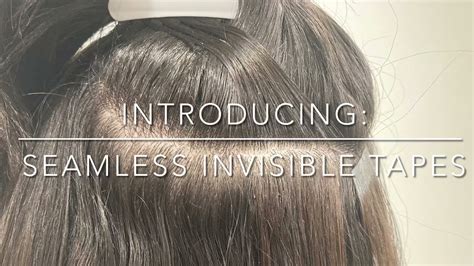Introduction
Hair extensions have become an increasingly popular way to add length, volume, and style to one’s natural hair. One of the key components in achieving a seamless and natural-looking blend with extensions is the use of tape for extensions. Tape for extensions, also known as hair extension tape or extension tape, is a thin, double-sided adhesive that secures the extensions to the natural hair. Choosing the right type of tape is crucial for ensuring the comfort, longevity, and overall success of the extension application.

Types of Tape for Extensions
There are four main types of tape for extensions, each with its unique characteristics and benefits:
1. Single-Sided Tape
Single-sided tape, as its name suggests, has adhesive on one side only. It is applied to the weft of the extension and then attached to the natural hair. Single-sided tape is typically used for short-term wear, as it is not as strong as other types of tape. However, it is relatively easy to apply and remove.
2. Double-Sided Tape
Double-sided tape has adhesive on both sides, making it more secure than single-sided tape. It is applied to the weft of the extension and then sandwiched between two sections of natural hair. Double-sided tape is suitable for both short-term and long-term wear, and it can provide a very strong hold.
3. Keratin Tape
Keratin tape is made from a natural protein found in hair. It is applied using a heat tool that melts the keratin, which then bonds with the natural hair. Keratin tape is highly durable and long-lasting, and it can create a very seamless and natural-looking blend. However, it is also more expensive and requires professional application.
4. Silicone Tape
Silicone tape is a type of non-adhesive tape that is used with tape-in extensions. It is applied to the weft of the extension and then attached to the natural hair using a special tool. Silicone tape is very flexible and comfortable to wear, and it can be reused multiple times. However, it is not as strong as other types of tape and may not be suitable for all types of hair.
Choosing the Right Type of Tape
The best type of tape for extensions will depend on the type of hair, the desired look, and the level of durability needed. Here are some factors to consider:
Hair Type
- Fine hair: Single-sided or double-sided tape with low tack
- Medium hair: Double-sided tape or keratin tape
- Thick hair: Double-sided tape or keratin tape with high tack
Desired Look
- Natural-looking blend: Keratin tape or double-sided tape
- Temporary volume: Single-sided tape
Durability
- Short-term wear: Single-sided tape
- Long-term wear: Double-sided tape, keratin tape
- Multiple uses: Silicone tape
Benefits of Tape for Extensions
Tape for extensions offers numerous benefits, including:
- Seamless blending with natural hair
- No damage to natural hair
- Comfortable and lightweight
- Easy to apply and remove
- Versatile and can be used to create a variety of looks
- Long-lasting and durable
Best Practices for Using Tape for Extensions
To ensure the best results with tape for extensions, follow these best practices:
- Use high-quality tape and extensions from reputable manufacturers
- Thoroughly cleanse and dry natural hair before application
- Section hair and apply tape to the weft of the extension
- Sandwich the extension between two sections of natural hair
- Press firmly to create a strong bond
- Use a fine-tooth comb to blend the extension and natural hair
- Avoid washing hair for 24-48 hours after application
Conclusion
Tape for extensions is an essential component for achieving a seamless and natural-looking blend with hair extensions. By choosing the right type of tape and following best practices for application, you can ensure a comfortable, long-lasting result.
